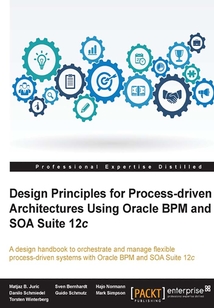首頁 > 計算機網絡 >
編程語言與程序設計
> Design Principles for Process:driven Architectures Using Oracle BPM and SOA Suite 12c最新章節目錄
舉報 

會員
Design Principles for Process:driven Architectures Using Oracle BPM and SOA Suite 12c
最新章節:
Index
ThisbookisintendedforBPMandSOAarchitects,analysts,developers,andprojectmanagerswhoareresponsiblefor,orinvolvedin,businessprocessdevelopment,modelling,monitoring,ortheimplementationofcomposite,process-orientedapplications.Theprinciplesarerelevantforthedesignofon-premiseandcloudsolutions.
目錄(128章)
倒序
- 封面
- 版權信息
- Credits
- About the Authors
- About the Reviewers
- www.PacktPub.com
- Preface
- Chapter 1. Business Process Management……
- The importance of business processes
- Business process management
- Business process modeling
- Process execution monitoring and analytics
- Process optimization
- Oracle BPM Suite
- How SOA and BPM fit together
- Summary
- Chapter 2. Modeling Business Processes for SOA – Methodology
- The postmature birth of enterprise BPM
- Oracle BPM Suite 12c – new business architecture features
- Football games – same basic rules different methodology
- Which BPM game do we play?
- Oracle BPM Suite 11g is made for playing Game Silo BPM
- Oracle BPM Suite models processes in BPMN
- Game Enterprise BPM
- Still wide open – the business/IT pide
- Oracle BPM Suite 12c tackles Game Enterprise BPM
- Using business architect features
- Properties of BA models
- Depicting organizational units
- Value chains
- Strategy models
- Key performance indicators
- Why we need a new methodology for Game Enterprise BPM
- Political change through Game Enterprise BPM
- Pair modeling the value chains and business processes
- Using guidelines and conventions to establish broad understanding
- BPM Methodology for Oracle BPM Suite
- Summary
- Chapter 3. BPMN for Business Process Modeling
- Business process classification and BPMN
- Business process diagrams
- Deeper analysis of BPMN elements
- General guidelines for business process modeling
- Process modeling patterns and BPMN
- Modeling an abstract BPMN process
- Top-down modeling: where the value chain meets BPMN
- Moving from process level 3 to level 4
- Differentiating automated process/workflows and page flows
- Summary
- Chapter 4. Process-driven Service Design
- Service design guidelines
- Data in the context of SOA
- Service virtualization
- Service design methodology
- Applying service design to RYLC
- Summary
- Chapter 5. Composite Applications
- SOA + applications = composite applications
- What are composite applications?
- Moving from the programmatic paradigm to the declarative paradigm
- The Oracle SOA Suite journey
- SCA as the next generation of containers
- Other types of integration logic that motivate a business rule engine
- Summary
- Chapter 6. Process Execution with BPMN and BPEL
- Implementation roadmap
- Using BPEL to implement fleet management
- Using BPMN to implement the rental process
- Best practices
- Summary
- Chapter 7. Human Interaction with Business Processes
- User experience guidelines
- User personas and user journeys within a business process
- Designing the user interface – wireframes task-driven process insight
- Task identification and patterns
- Invoking human tasks from BPMN and BPEL
- Building task-driven user interfaces – workspace web forms ADF .Net
- Best practice considerations – performance extensibility upgrade protection
- Summary
- Chapter 8. Business Rules
- Why business rules within BPM are important?
- How to design rules and how to organize them
- Using rules
- Best practices
- Example – adding rules to BPMN and BPEL
- Summary
- Chapter 9. Adaptive Case Management
- The people do matter – not the machines
- The characteristics of ACM
- ACM and business analytics
- The basic concepts of adaptive case management in Oracle BPM Suite
- Modeling a case
- Building your own case UI on top of the Case API
- Sample – ACM at RYLC
- Best practices
- Summary
- Chapter 10. Mobile and Multichannel
- Development of mobile solutions
- HTML5 – cross-platform technology
- Single-page web apps
- Hybrid apps
- The shift in web development
- UX design
- Mobile solutions and SOA
- Mobile solutions and BPM
- Use cases
- Oracle Mobile Tooling
- Mobile use case for RYLC with MAF
- Summary
- Chapter 11. Event Processing and BPM
- What is fast data?
- What is event processing?
- The key elements of event processing
- Event processing versus Business Rule Management Systems
- Conceptual architecture for event processing
- Self-contained versus claim check event messages
- How does event processing fit into a modern architecture?
- Event processing architectural patterns
- Summary
- Chapter 12. Business Activity Monitoring
- What is BAM?
- Oracle BAM 12c architecture
- BAM Process Analytics
- Monitoring RYLC with BAM
- BAM integration with BPEL and BPM
- BAM best practices
- Summary
- Index 更新時間:2021-07-16 14:04:53
推薦閱讀
- PHP程序設計(慕課版)
- Vue.js快速入門與深入實戰
- Python Deep Learning
- Java 9模塊化開發:核心原則與實踐
- 計算機應用基礎教程(Windows 7+Office 2010)
- 愛上C語言:C KISS
- Learning Android Application Testing
- Simulation for Data Science with R
- 超好玩的Scratch 3.5少兒編程
- Java 11 and 12:New Features
- Unity 5 Game Optimization
- Mastering Machine Learning with scikit-learn
- Visual Basic.NET程序設計
- Hands-On Artificial Intelligence with Unreal Engine
- Flask Web開發實戰:入門、進階與原理解析
- 區塊鏈原理、設計與應用
- Java王者歸來:從入門邁向高手
- Python機器學習
- HTML5+CSS3+JavaScript從入門到精通(微課精編版)
- 輕松玩轉Scratch 3.0編程(第2版)
- Oracle Application Integration Architecture(AIA) Foundation Pack 11gR1:Essentials
- GNOME 3 Application Development Beginner's Guide
- Oracle數據庫基礎與應用教程
- R語言數據可視化實戰:大數據專業圖表從入門到精通(微視頻全解版)
- C語言程序設計案例教程(第3版)
- Web Penetration Testing with Kali Linux(Second Edition)
- Windows PowerShell for .NET Developers(Second Edition)
- 代碼精進之路:從碼農到工匠
- PHP5應用實例詳解
- Python編程從零開始學(視頻教學版)

